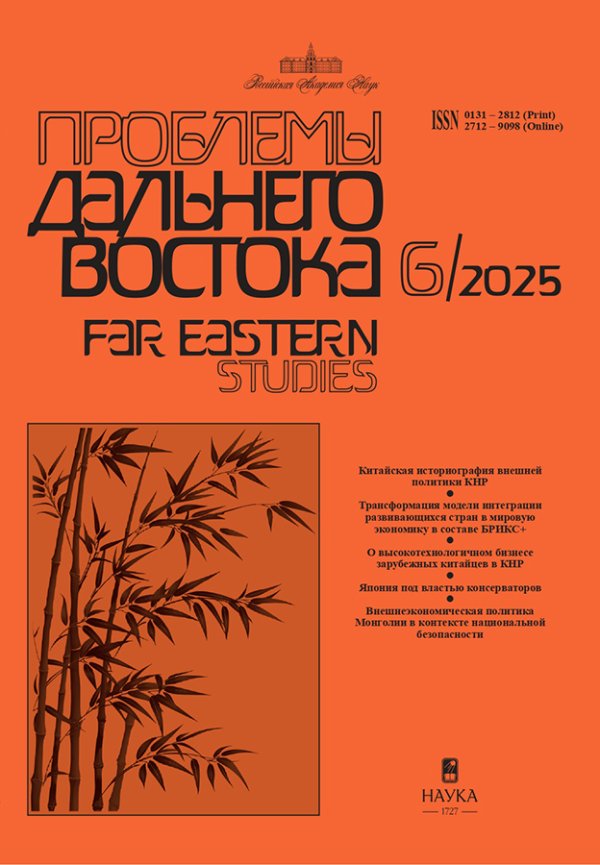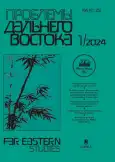His Majesty’s Eyes and Ears: on the Establishment of the Institution of Control of Provincial Authorities in Korea during the Joseon Period
- Authors: Pirozhenko O.S1
-
Affiliations:
- Institute of Asian and African Studies, Lomonosov Moscow State University
- Issue: No 1 (2024)
- Pages: 125-138
- Section: History
- URL: https://journals.rcsi.science/0131-2812/article/view/259528
- DOI: https://doi.org/10.31857/S0131281224010104
- ID: 259528
Full Text
Abstract
The article characterizes the evolution of the royal emissaries of the Joseon period Korea (1392–1897). The institution was a significant element in the Korean court and state apparatus balance of power, functioning as an instrument of control over regional authorities, and, at times, as a lever of direct provincial administration. The study, based on original Korean sources, allows a better understanding of development of the state management system that influenced shaping of the historical specifics of Korea's development in the reviewed period. The basis for the development of the institution during the formation of Joseon statehood was provided by the local governance practice established during the previous Goryeo dynasty (935–1392), which utilized two key features: assigning emissaries with supervisory functions to overcome local autonomy and introducing temporary positions for implementation of large-scale projects. The administrative reorganization aimed at bureaucratic centralization of power, which accompanied the accession of the new dynasty at the end of the 14th century, had the establishment of a regular gubernatorial system as one of its key elements in provincial dimension. Nevertheless, the rulers of the Joseon state continued to actively utilize the practice of dispatching authorized envoys who performed control, supervisory and management functions in parallel with the governors permanently stationed in provinces. In most cases, the emissary positions were filled with Korean monarchs’ confidants whose assignments were intended to balance the influence of local authorities and ensure balance of provincial governance. Through the first decades of the Lee dynasty’s rule this institution proved its relevance in new conditions, when, among the priorities of state policy, the effort to check local autonomy gave way to strivings for controllability and effectively solving socio-economic and infrastructural development tasks.
About the authors
O. S Pirozhenko
Institute of Asian and African Studies, Lomonosov Moscow State University
Author for correspondence.
Email: pirojenko2000@mail.ru
ORCID iD: 0000-0002-8090-3407
Postgraduate student
Moscow, Russian FederationReferences
- Lan'kov A.N. Politicheskaya bor'ba v Koree v XVI-XVIII vv. [Political Struggle in Korea in XVI-XVIII centuries]. SPb., Centr «Peterburgskoe Vostokovedenie», 1995. 200 s. (In Russ.)
- Li Sunsin. Voennyj dnevnik [The War Diary] / Vstupit. stat'ya, per. s hanmuna, komment. i pril. Pirozhenko. O.S. M., Nauka — Vost. lit., 2013. 375 s. (In Russ.)
- Kurbanov S.O. Kurs lekcij po istorii Korei [Korea History Lectures]. SPb., Izdatel'stvo SanktPeterburgskogo universiteta, 2002. 626 s. (In Russ.)
- Pirozhenko O.S. Ob osobennostyah sistemy regional'nogo upravleniya Korei v XIV—XV vv.: rol' instituta upolnomochennyh chinovnikov na primere deyatel'nosti Han Myonhve iz roda chkhondzhusskih Hanov [Regional governance in 14th-15th century Korea: the role of king’s provincial envoys seen through the case of Han Myeong-Hoe of Cheongju Han clan]. Koreevedenie. 2022. No. 1. S. 44–65. (In Russ.)
- Rybakov V.M. Tanskaya byurokratiya [Tang bureaucracy]. CHast' 1: Genezis i struktura. SPb., Peterburgskoe Vostokovedenie, 2009. 512 s. (In Russ.)
- Volkov S.V. Chinovnichestvo i aristokratiya v rannej istorii Korei [Officialdom and Aristocracy in Early Korean History]. M., Nauka, 1987. 289 s. (In Russ.)
- Zakony Velikoj dinastii Min so svodnym kommentariem i prilozheniem postanovlenij [The Great Ming Code with commentary and arrangements]. CH. I. / Per. s kit., issled., primech. i prilozh. N.P. Svistunovoj. M., Izdatel'skaya firma «Vostochnaya literatura» RAN, 1997. 573 s. (In Russ.)
- 經國大典 [The Great Code of Government]. 규장각. 奎1298-v.1–4. 1661. (In Chin.)
- 高麗史 [Koryo History]. URL: http://db.history.go.kr/id/kr_075_0010_0010_0050_0080 (accessed: 19.12.2023). (In Chin.)
- 김남규. 고려양계지방사연구 [Kim Nam Kyu. History of Yanggye region of Koryo]. 서울, 새무사, 1989. 198 쪽. (In Kor.)
- 김순남. 조선초기 체찰사연구 [Kim Soon Nam. The Study fo Che-chal-sa during the early Joseon dyinasty]. 서울, 경인문화사, 2007. 281 쪽. (In Kor.)
- 김태은. 고려의 지방통치구조로 본 전근대 국가의 성립원리 [Kim Tae Eun. Premodern state founding principles seen though the Koryo regional government system]. 서울, 연세대학교 사회학 석사학위 논문, 1999. 163 쪽. (In Kor.)
- 박종진. 고려시기 계수관의 기능과 위상 [Park Jong Jin. Function and status of Koryo Kyesugwan]. 역사와 현실. No. 56. 2005. 173–201 쪽. (In Kor.)
- 변태섭. 고려안찰사고 [Byun Tae Seop. Koryo Anchalsa]. 역사학보. 1971. No. 40. 1–52 쪽. (In Kor.)
- 三峯集 [Sambong sritings collection]. URL: http://db.itkc.or.kr/inLink?DCI=ITKC_MO_0024A_A005_404L_IMG (Accessed: 19.12.2023). (In Chin.)
- 朝鮮王朝實錄 [The annals of the Joseon dynasty]. 太白山史庫本. (In Chin.)
- 조승호. 조선시대 관찰사의 수령고과 기능의 문제점과 대책에 관한 연구 [Jo Seung Ho. Joseon Sooryung performance evaluation by Kwanchalsa: problemas and solutions]. 인문과학연구. 1997. No. 5. 173–189 쪽. (In Kor.)
- 崔先惠. 高麗末, 朝鮮初觀察使論의 전개와 中央集權體制의 정비 [Choe SeonHye. Development of discussion on Kwanchalsa and the centralization of power in sate Koryo and early Joseon dynasties]. 國史館論叢. 1997. 第76輯. 1–21 쪽. (In Kor.)
- 이수건. 한국중세사회사연구 [Lee Soo Geon. History of Korea's medieval society]. 서울, 일조각, 1984. 512 쪽. (In Kor.)
- 이존희. 조선 전기의 관찰사제 [Lee John Hee. The Kwanchalsa system of early Yi Dynasty]. 서울 시립대학논문집. 1985. No. 18. 27–67 쪽. (In Kor.)
- 이인재. 고려말 안렴사와 도관찰출척사 [Lee In Jae. Anryomsa and dokwanchalchulcheoksa of late Koryo]. 역사연구. 1993. No. 2. 41–68 쪽. (In Kor.)










